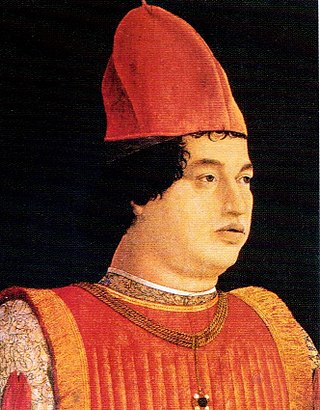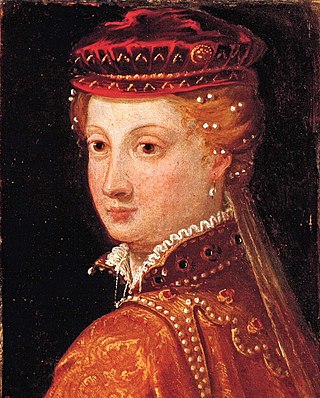
Mantua is a city and comune in Lombardy, Italy, and capital of the province of the same name.

The House of Gonzaga is an Italian princely family that ruled Mantua in Lombardy, northern Italy from 1328 to 1708. They also ruled Monferrato in Piedmont and Nevers in France, as well as many other lesser fiefs throughout Europe. The family includes a saint, twelve cardinals and fourteen bishops. Two Gonzaga descendants became empresses of the Holy Roman Empire, and one became queen of Poland.

Ludovico III Gonzaga of Mantua, known as the Turk, also spelled Lodovico was the ruler of the Italian city of Mantua from 1444 to his death in 1478.

The Duchy of Mantua was a duchy in Lombardy, northern Italy. Its first duke was Federico II Gonzaga, member of the House of Gonzaga that ruled Mantua since 1328. The following year, the Duchy also acquired the March of Montferrat, thanks to the marriage between Gonzaga and Margaret Paleologa, Marchioness of Montferrat.

Federico I Gonzaga was marquess of Mantua from 1478 to 1484, as well as a condottiero.

Mantua Cathedral in Mantua, Lombardy, northern Italy, is a Roman Catholic cathedral dedicated to Saint Peter. It is the seat of the Bishop of Mantua.

The Diocese of Mantua is a Latin Church ecclesiastical territory or diocese of the Catholic Church in Italy. The diocese existed at the beginning of the 8th century, though the earliest attested bishop is Laiulfus (827). It has been a suffragan of the Archdiocese of Milan since 1819.
Carlo Gonzaga, Lord of Sabbioneta, was an Italian nobleman of the Mantuan House of Gonzaga who rose to the position of Captain of the People in the Ambrosian Republic of Milan, and eventually ruled practically as an autocrat. He was the younger son of Gianfrancesco Gonzaga and Paola Malatesta, as well as a friend of the humanist writer Francesco Filelfo. His brother was Ludovico III Gonzaga, Marquis of Mantua, and became a rival of his for Mantua and in the field of battle.

Isabella Clara of Austria was a Duchess consort of Mantua, Montferrat, Nevers, Mayenne and Rethel by marriage to Charles II, Duke of Mantua and Montferrat.

Eleonora Gonzaga, Duchess of Urbino was Duchess and sometime regent of Urbino by marriage to Francesco Maria I della Rovere, duke of Urbino. She served as regent during the absence of her spouse in 1532.
Sigismondo Gonzaga was an Italian cardinal. He was the third son of Federico I Gonzaga, Marquess of Mantua.

Barbara of Brandenburg was a Marchioness consort of Mantua, married in 1433 to Ludovico III Gonzaga, Marquis of Mantua. She was referred to as a virago because of her strong character and forceful nature, and served as Regent of Mantua several times during the absence of Ludivico III between 1445 and 1455. She is regarded as an important figure in the Italian Renaissance and was a student of Vittorino da Feltre.

Francesco Gonzaga was an Italian bishop and a Cardinal of the Roman Catholic Church during the reigns of Popes Pius II, Paul II and Sixtus IV.

Gianfrancesco Gonzaga was the third son of Ludovico III Gonzaga, Marquess of Mantua and Barbara of Brandenburg. He was the first Count of Sabbioneta from 1479 until his death, originating the later Princely Gonzaga-Sabbioneta, Gonzaga-Bozzolo, Gonzaga-Gazzuolo and Gonzaga-San Martino lines of the Gonzaga family.

The Marquisate of Oristano was a marquisate of Sardinia that lasted from 1410 until 1478

The Ceva Grimaldi are an Italian noble family established in Southern Italy since the 16th century but whose origins are in Piedmont and Liguria and date back to the 10th century. The main titles associated with this branch of the Ceva family are Marchese di Pietracatella and Duca di Telese.

Paola Agnese Malatesta also Paola of Mantua was an Italian noblewoman of the noble family House of Malatesta, rulers of Rimini and Pesaro. She was born in Pesaro in 1393 to Malatesta IV Malatesta, lord of Pesaro and Fossombrone, and Elisabetta da Varano. On 22 August 1409 she married Gianfrancesco Gonzaga, leader of Mantua, in Pesaro. She was the first Marquesa of Mantua after her husband received the title. Paola had six children. This union introduced the genetic disease of kyphosis to the Gonzaga family which showed in subsequent generations.

The Fasti of the Gonzagas or Gonzaga Cycle is a 1578-1580 cycle of oil on canvas paintings commissioned from Tintoretto and his workshop by Guglielmo Gonzaga to hang in two of the new rooms he had added to the Palazzo Ducale in Mantua. They celebrate the history of the Gonzaga family, particularly its military triumphs in the 15th and 16th centuries, and remained in the city until being taken to Venice in the early 18th century by the tenth and final Gonzaga duke Ferdinando Carlo Gonzaga. There they were bought in 1708 by Maximilian II Emanuel, Elector of Bavaria for his collection in Munich, where they still hang in the Alte Pinakothek.


















